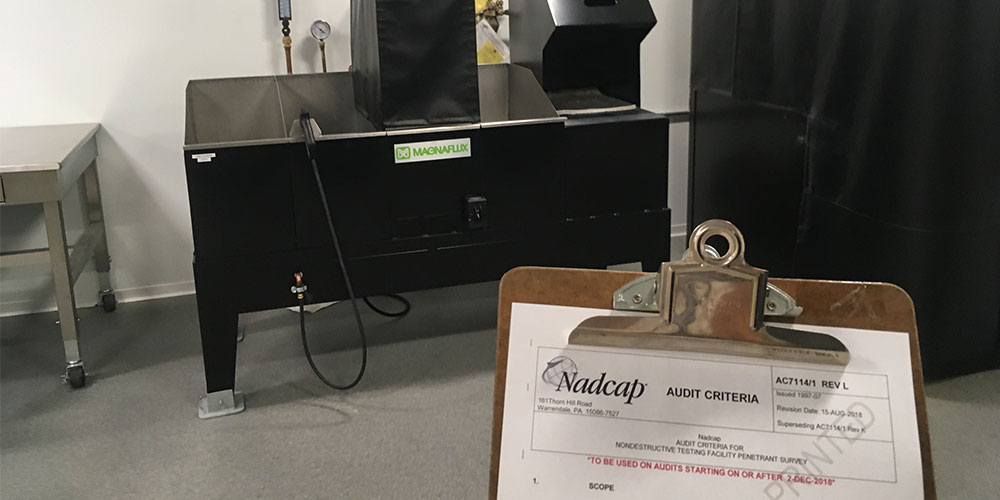By David Geis, Product Manager

Nothing in Penetrant Testing generates as much controversy as Known Defect Standards. There are as many opinions out there as there are Level III’s, and then some. It should be no surprise that the daily System Performance Test and handling of Known Defect Standards have been among the top 5 Nadcap audit findings for years. Between May 2017 and 2018, there were over 70 findings reported for demonstration of the system performance test, making it the #2 NCR for penetrant systems. In fact, that’s better than the previous year which had nearly 190 NCRs reported. What do you need to do to make sure you’re in compliance?
Within the penetrant checklist AC7114/1, section 5.9 covers the System Performance Check.
Because the System Performance Check is a comparison, the intent here is to establish the baseline performance of the panel on your specific system with your materials and operating parameters. Sometimes penetrant users will ask us to provide this baseline picture of a known defect standard for them. We’re not able to do that because our PeneCert lab uses standardized materials and parameters. While our PeneCert service can perform a panel degradation check (see below), that’s not the same thing as establishing a baseline on your own system.
The performance of the system needs to be verified at least prior to use. If the system is used daily, then the check needs to be performed at least once per day. If the system is used periodically, then it only needs to be checked before it is used. The intent here is to make sure that all in-use materials are still performing the same as the established baseline.
As with all quality checks, the results of the check need to be recorded. The intent here is to document that the system is performing the same as the established baseline. For TAM 146040 test panels or KDS panels, the number and appearance of the starbursts should be noted and compared to the established baseline (photo or other record). Any change in number or appearance should be investigated.
This is where the most audit findings occur – demonstrating the system performance check to the auditor. The known defect standard should be run through the penetrant system (or processed with the same materials and parameters), and the inspector should compare the results to the established baseline for that specific panel on that system. The intent is to confirm that procedures to verify system performance are being followed.
The system performance check is a comparison to the established baseline. The intent here is to make sure that any change in performance is investigated so that corrective actions can be taken. A decrease in performance may be the result of penetrant contamination, incorrect emulsifier concentration, developer contamination, incorrect dwell times, or even problems with the dryer controls. Procedures should be in place to determine the cause of the change.
The requirements for the Known Defect Standards themselves are in Section 5.10 of the checklist.
The most common cause of a failed system performance check is poor cleaning of the known defect standard. Panels should be thoroughly cleaned immediately after use and stored properly to prevent buildup of materials in the artificial flaws. The intent here is to make sure that detailed procedures are in place to keep the known defect standards in good condition.
The most common known defect standards are TAM 146040 test panels. These are steel panels with hard chrome plating which is stressed to produce the characteristic starburst cracks. Of course, cracks grow over time (which is why we perform NDT in the first place). The intent here is to check the panel with standard materials and parameters to determine if it has changed in a way that would skew the results. This degradation check may be performed on-site or sent to an outside lab such as our PeneCert service.
After a panel degradation check is performed, using standard materials and parameters, the results should be compared to the last standard performance. In the case of starburst-type panels, the size of the indications should be within 30% of the previous results. In the case of Ni-Cr or other panels, the number of visible indications should be within 30% of the previous results. The intent here is to ensure that the known defect standard is still within tolerance to its original performance, and not introducing a bias that would skew the daily system performance checks.
Several Nadcap subscribers have added requirements for the system performance check and for known defect standards. These added requirements are found in the Supplemental checklist AC7114/1S. Be sure to check the supplement and advisories on eAuditNet.com for details to make sure your penetrant system is in full compliance.
Nadcap checklists and audit advisories can be downloaded from www.eauditnet.com. Customers who are Nadcap suppliers will have their own login.
Published September 25, 2018
JOIN OUR MAILING LIST TO RECEIVE THE LATEST NDT INSIGHTS AND ARTICLES FROM MAGNAFLUX
155 Harlem Avenue
Glenview, IL 60025, USA
Telephone: +1 847-657-5300
Contact Magnaflux Customer Service